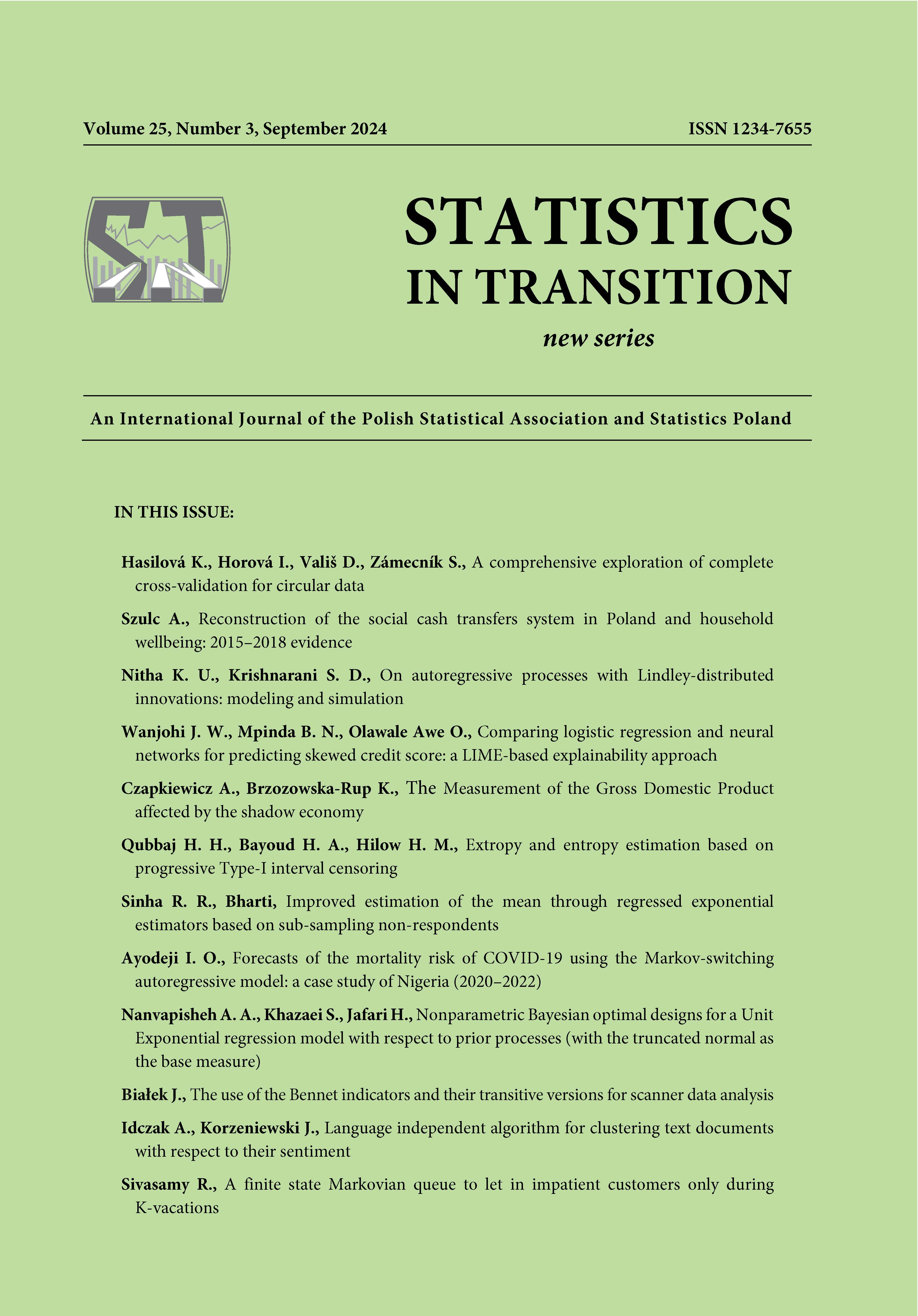ARTICLE
ABSTRACT
The global pandemic due to SARS-Cov-2 ravaged the world and killed more than 6 million people globally within two years. Studies predicting future occurrences are essential to effectively combat the virus. This study modeled daily fatality rate in Nigeria from March 23, 2020 to March 19, 2022 and forecast future occurrences using Markov switching model (MSM). MSM estimates segmented fatality rates into three states of low-, medium- and high-risks. Further, estimates revealed that as at 19th March, 2022, Nigeria remained at the low-risk regime in which 1 (95%CI: 0, 1) person, on the average, died of coronavirus daily; however, the most probable scenario in the nearest future was the medium-risk state in which an average of 4 (95%CI: 2, 5) persons would die daily with 48.7% probability. The study concluded that Nigerian COVID mortality risks followed a switching pattern which fluctuated within low-, medium- and high-risks; however, the medium-risk state was most likely in the future. Our results indicated that the quarantine measures adopted by the governments yielded positive results. It also underscored the need for governments and individuals to intensify efforts to ensure that the country remained at the low-risk zone till the virus would be eventually eradicated.
KEYWORDS
Nigeria, hidden Markov, autoregressive, coronavirus death rate.
REFERENCES
Abdulmajeed, K., Adeleke, M., Popoola, L., (2020). Online forecasting of covid-19 cases in Nigeria using limited data. Data in Brief , Vol. 30, 105683.
Adekunle, A. I., Adegboye, O. A., Gayawan, E., McBryde, E. S., (2020). Is Nigeria really on top of COVID-19? Message from effective reproduction number. Epidemiology and Infection. Vol. 148, pp. 1–7, https://doi.org/10.1017/S0950268820001740.
Ahlburg, D., (1995). Simple versus complex models: evaluation, accuracy, and combining. Math Popul Stud., Vol. 5, pp. 281–290, doi: 10.1080/08898489509525406.
Anne, W. R., (2020). ARIMA modelling of predicting COVID-19 infections, medRxiv, https://doi.org/10.1101/2020.04.18.20070631.
Bagal, D. K., Rath, A., Barua, A., Patnaik, D., (2020). Estimating the parameters of the susceptible-infected-recovered model of COVID-19 cases in India during lockdown periods. Chaos Solitons Fractals, https://doi.org/10.1016/j.chaos. 2020.110154.
Bello, B., Amzat, J., (2021). The Theory isn’t dead: A Classical Sociological Gaze of COVID-19. Tanzania Journal of Sociology, Vol. 7, pp. 48–61.
Carcione, J. M., Santos, J. E., Bagaini, C., Ba, J., (2020). A simulation of a COVID-19 epidemic based on a deterministic SEIR model. Front Public Health, Vol. 8, https://doi.org/10.3389/fpubh. 2020.00230.
Chigbu, B. C., Edikpa, E. C., Onu, E. A., Nwabueze, A. I., Aneke, M. C., Vita-Agundu, U. C., Adepoju, E. B., (2021). Analysis and forecasting of confirmed, death, and recovered cases of COVID-19 infections in Nigeria: Implications for university administrators. Medicine, Vol. 100.
Didi, E. S., Kingdom, N., Harrison, E. E., (2021). ARIMA modeling and forecasting of COVID-19 daily confirmed/death cases: A case study of Nigeria. Asian Journal of Probability and Statistics, Vol. 12, pp. 59–80.
Engel, C., Hamilton, J. D., (1990). Long swings in the dollar: are they in the data and do markets know it? The American economic review, Vol. 80, pp. 689–713.
Hamilton, J. D., (1989). A new approach to the economic analysis of nonstationary time series and the business cycle. Econometrica, Vol. 57, pp. 357–384.
Ibrahim, R. R., Oladipo, H. O., (2020). Forecasting the spread of COVID-19 in Nigeria using Box-Jenkins Modeling Procedure. MedRxiv, https://doi.org/10.1101/ 2020.05.05.20091686.
Ibrahim, S., Rasul, A., Ozigis, M. S., Adamu, B., (2021). Comparing the accuracies of forecasting models from the time series data of covid-19 infection in Nigeria. European Journal of Public Health Studies, Vol. 4, doi. 10.46827/ejphs.v4i2.106.
Ihekweazu, C., (2020). Steps Nigeria is taking to prepare for cases of coronavirus, http://theconversation.com/steps-nigeria-is-taking-to-prepare-for-cases-of-coronavirus-130704.
Ileyemi, M., (2021). COVID-19: Nigeria records 93 deaths, 362 new cases. Premium Times, Nigeria 30 August, 2021.
Jacobs, E., Okeke, M., (2022). A critical evaluation of Nigeria’s response to the first wave of COVID-19. Bull. Natl. Res. Cent., Vol. 46.
Khan, F., Lounis, M., (2021). Short-term forecasting of daily infections, fatalities and recoveries about COVID-19 in Algeria using statistical models. Beni-Suef University Journal of Basic and Applied Sciences, Vol. 10, https://doi.org/ 10.1186/s43088-021-00136-5.
Li, C., Sampene, A. K., Agyeman, F. O., Robert, B., Ayisi, A. L., (2022). Forecasting the Severity of COVID-19 Pandemic Amidst the Emerging SARS-CoV-2 Variants: Adoption of ARIMA Model. Computational and Mathematical Methods in Medicine, Vol. 2022, https://doi.org/10.1155/2022/3163854.
Marbot, O., (2020). Coronavirus Africa Map: Which Countries are Most at Risk? https://www.theafricareport.com/23948/coronavirus-africa-which-countries-are-most-at-risk/.
Mthethwa, N., Chifurira, C., Chinhamu, K., (2022). Estimating the risk of SARS-CoV-2 deaths using a Markov switching-volatility model combined with heavy-tailed distributions for South Africa. BMC Public Health, Vol. 22.
Odekina, G. O., Adedotun, A. F., Imaga, O. F., (2022). Modeling and Forecasting the Third wave of Covid-19 Incidence Rate in Nigeria Using Vector Autoregressive Model Approach. Journal of the Nigerian Society of Physical Sciences, Vol. 4, pp. 117–122.
Ogundokun, R. O., Lukman, A. F., Kibria, G. B., Awotunde, J. B., Aladeitan, B. B., (2020). Predictive modelling of COVID-19 confirmed cases in Nigeria. Infectious Disease Modelling, Vol. 5, pp. 543–548.
Oliveira, A., Binner, J., Mandal, A., Kelly, L., Power, G., (2021). Using GAM functions and Markov-Switching models in an evaluation framework to assess countries’ performance in controlling the COVID-19 pandemic. BMC Public Health, Vol. 21.
Pourghasemi, H. R., Pouyan, S., Farajzadeh, Z., Sadhasivam, N., Heidari, B., Babaei, S., Tiefenbacher, J. P., (2020). Assessment of the outbreak risk, mapping and infestation behavior of COVID-19: application of the autoregressive integrated and moving average (ARIMA) and polynomial models, PloSOne, Vol. 15, https://doi.org/10.1371/journal.pone.0236238.
Sharifi, Y., Ebrahimpur, M., Payab, M., Larijani, B., (2022) The Syndemic Theory, the COVID-19 Pandemic, and The Epidemics of Non-Communicable Diseases (NCDs). Medical Journal of the Islamic Republic of Iran, Vol. 36.
Singh, R. K., Rani, M., Bhagavathula, A. S., Sah, R., Rodriguez-Morales, A. J., KalitaH, N. C., Sharma, S., Sharma, Y. D., Rabaan, A. A., (2020). Prediction of the covid-19 pandemic for the top 15 affected countries: advanced autoregressive integrated moving average (arima) model, JMIR Public Health Surveill., Vol. 6, https://doi.org/10.2196/19115.
Taleb, N., (2007). The Black Swan: The Impact of the Highly Improbable. New York: Random House, vol. 2, https://innovation.cc/book-reviews/2008_13_3_14_gow_ bk-rev_taleb_black-swan.
Worldometer, (2022) Nigeria COVID: Coronavirus Statistics - Worldometer, April 2022, https://www.worldometers.info/coronavirus/country/nigeria/.
